India’s growth drivers, especially in the manufacturing sector, are moving from urban to rural areas. This has enabled the country’s rural economy to grow at a faster pace, growing by a real annual average of 7.3% during the past decade, compared to 5.4% in the urban economy. India’s rural awakening has the potential to achieve double-digit growth rates if the pace of structural transformation can be accelerated in rural zones. This requires increased investment in physical and human infrastructure.
Unfortunately, our physical infrastructure investments remain concentrated in urban India. The country’s urban infrastructure investments have increased by a staggering 600% during the last decade, and rural India continues to face significant deficiencies, with lower quality and quantity of infrastructure facilities than in urban areas. This has constrained the pace of rural awakening in India, where roughly two-thirds of the population still live, even if the proportion is in decline because of migration to cities.
Conventional wisdom suggests that economic growth, industrialization and urbanization grow together, hand in hand. India’s industrialization and urbanization did grow together in the early 1990s, and manufacturing growth was initially concentrated around the mega cities. But this has changed during the last two decades—and the manufacturing sector is spatially spreading from urban to rural areas.
India’s low-density manufacturing districts are growing at a much faster pace than high-density districts. This dispersion of the manufacturing sector from urban to rural and from dense to less dense districts has accelerated a structural transformation, improved allocation of resources, promoted the growth of more efficient enterprises and reduced our spatial imbalance of enterprises.
However, the manufacturing sector has not spread to all districts. Only those districts that have improved their physical and human infrastructure have attracted such businesses. Though the spatial evolution trend in the manufacturing sector is like trends found in China and the US, the speed and pace of spatial spread is much slower in India.
While large manufacturing enterprises are moving away from more congested megacities into rural areas, this is not happening at a fast enough pace to create significantly more jobs. In China, Europe and the US, the manufacturing sector has already dispersed from high-density urban clusters to less dense rural areas.
India’s future in the manufacturing sector is no longer in urban areas, which are costly, dense and suffer from huge congestion costs. The future is in rural areas and this requires scaling up investments in those parts. This can be achieved by combining resources—Centre and state; international and domestic; and private, corporate and philanthropic. The challenge is to increase the scale of financial resources, improve linkages and build partnerships between urban and rural areas.
The biggest asset of rural India is land. But land markets are hugely distorted in India, as inefficient but well-connected enterprises tend to grab more of it than more productive enterprises. This has restrained productivity growth in rural areas. Because land is used as collateral for bank loans, capital allocation is also distorted by this. In general, land markets remain much more distorted than capital and labour markets in India. The rural economy will make huge gains if land-market distortions can be reduced.
Rising rural protests in India are not just a reflection of concerns regarding agricultural reforms, but a symbol of rising aspirations in the countryside. People are now demanding more jobs and a better quality of life in rural areas. Although agricultural pricing reforms may be viewed as a way of dealing with rural distress, this is not a substitute for unleashing a comprehensive plan for the structural transformation of rural India. The path out of rural distress is through reforms that will expand the manufacturing sector and size of the middle class, scaling up the country’s march towards green growth, and create many more jobs.
A successful rural awakening will result in higher productivity in both the farm and non-farm sectors, ensure food security for India’s urban population, and generate local resources for self advancement. Advances in computing power, connectivity, artificial intelligence, biotechnology, and GIS can promote inclusive agriculture and diversify the sectors that sustain rural livelihood.
Sustainable growth and development require a continuous transformation of the economy towards higher value-added sectors and activities. Some initiatives hold promise. Projects like the Andhra Pradesh Integrated Irrigation and Agriculture Transformation Project can help smallholder farmers increase their agricultural productivity, profitability and climate resilience. The Indian government can provide basic housing. People in India’s rural areas expect a shift from farm-to non-farm jobs and less dependence on agriculture. This can be achieved.
The author is a senior fellow at Pune International Development Center.
Unlock a world of Benefits! From insightful newsletters to real-time stock tracking, breaking news and a personalized newsfeed – it’s all here, just a click away! Login Now!
Download The Mint News App to get Daily Market Updates.
More
Less
Published: 17 May 2024, 06:00 PM IST
#Indias #rural #awakening #economic #growth #engine
